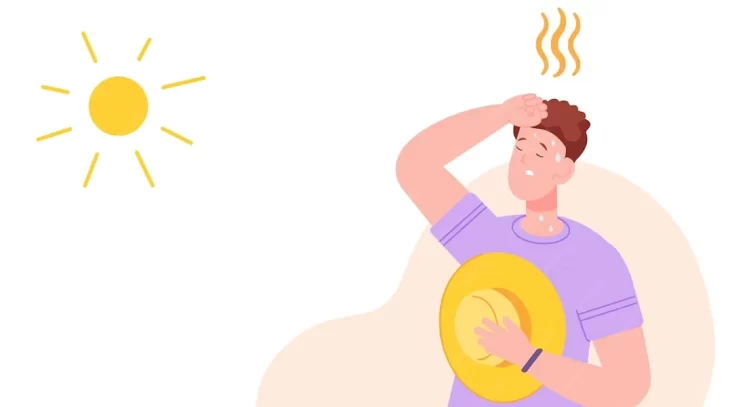Heatstroke is a serious and potentially life-threatening condition that occurs when the body’s temperature regulation system fails, leading to an excessively high core body temperature. Understanding heatstroke is essential for recognizing its symptoms, taking preventive measures, and providing appropriate treatment.
What is Heatstroke?
Heatstroke, also known as sunstroke, is a severe form of hyperthermia where the body’s core temperature rises to 104°F (40°C) or higher. This condition typically results from prolonged exposure to high temperatures, often in combination with dehydration, which impairs the body’s ability to cool itself through sweating.
Causes of Heatstroke
- Environmental Factors:
- High Temperatures: Extended exposure to hot weather, especially during heatwaves, increases the risk.
- Humidity: High humidity levels can prevent sweat from evaporating, hindering the body’s cooling process.
- Sun Exposure: Direct sunlight can exacerbate the effects of high temperatures, particularly during peak hours (10 a.m. to 4 p.m.).
- Exertional Heatstroke:
- Strenuous Activity: Engaging in intense physical activities, such as sports or manual labor, in hot conditions can lead to heatstroke, especially if proper hydration is not maintained.
- Other Contributing Factors:
- Age: The elderly and young children are more susceptible due to their bodies’ reduced ability to regulate temperature.
- Health Conditions: Chronic illnesses, such as heart disease, respiratory issues, and obesity, can increase vulnerability.
- Medications: Certain medications, including diuretics, antihistamines, and antidepressants, can affect the body’s ability to stay hydrated and regulate temperature.
- Alcohol and Drug Use: Alcohol and stimulants can impair the body’s heat response mechanisms.
Symptoms of Heatstroke
Recognizing the symptoms of heatstroke is critical for timely intervention. Common symptoms include:
- High Body Temperature: Core body temperature of 104°F (40°C) or higher.
- Altered Mental State: Confusion, agitation, slurred speech, irritability, seizures, and loss of consciousness.
- Skin Changes: Hot, dry skin (due to failure of the sweating mechanism), although in exertional heatstroke, the skin may feel moist.
- Nausea and Vomiting: Feeling sick and experiencing vomiting.
- Rapid Heart Rate and Breathing: Accelerated heartbeat and shallow, rapid breathing.
- Headache: Intense headache and dizziness.
Preventing Heatstroke
Prevention is key to avoiding heatstroke. Here are some effective strategies:
- Stay Hydrated:
- Drink plenty of fluids, especially water, throughout the day. Avoid alcohol and caffeinated beverages, as they can contribute to dehydration.
- Dress Appropriately:
- Wear lightweight, light-colored, loose-fitting clothing to help the body regulate temperature. A wide-brimmed hat and sunglasses can protect against direct sunlight.
- Limit Sun Exposure:
- Stay indoors during the hottest parts of the day. If you must be outside, take frequent breaks in the shade or a cool environment.
- Use Sunscreen:
- Apply broad-spectrum sunscreen with an SPF of at least 30 to protect your skin from sunburn, which can affect the body’s ability to cool down.
- Adapt Activities:
- Schedule strenuous activities for cooler parts of the day, such as early morning or late evening. Gradually acclimatize to hot conditions if you are not used to them.
- Monitor Vulnerable Individuals:
- Keep a close eye on the elderly, young children, and those with chronic illnesses. Ensure they stay hydrated and cool.
Treatment of Heatstroke
Immediate action is essential when dealing with heatstroke to prevent complications or fatalities. Follow these steps:
- Call Emergency Services:
- Heatstroke is a medical emergency. Call 911 or your local emergency number immediately.
- Move to a Cooler Environment:
- Get the affected person out of the heat and into a cooler, shaded, or air-conditioned space.
- Lower Body Temperature:
- Remove excess clothing and apply cool water to the skin. Use a sponge, wet towels, or a cool bath. Avoid using ice-cold water, as it can cause shivering and raise body temperature.
- Use fans or air conditioning to help cool the person down.
- Hydrate Carefully:
- If the person is conscious and able to drink, provide cool (not cold) water. Avoid sugary or caffeinated beverages.
- Monitor Vital Signs:
- Keep track of the person’s temperature, breathing, and level of consciousness until professional medical help arrives.
Complications of Heatstroke
Without prompt treatment, heatstroke can lead to severe complications:
- Organ Damage: Prolonged high body temperature can cause damage to the brain, heart, kidneys, and muscles.
- Heat Cramps and Heat Exhaustion: Milder forms of heat-related illnesses can progress to heatstroke if not addressed.
- Rhabdomyolysis: Breakdown of muscle tissue can release harmful substances into the bloodstream, potentially leading to kidney failure.
- Shock: Circulatory shock can occur due to severe dehydration and electrolyte imbalances.
Conclusion
Heatstroke is a critical medical condition that requires immediate attention. Understanding its causes, recognizing symptoms, and knowing how to prevent and treat it can save lives. Staying hydrated, dressing appropriately, limiting sun exposure, and being mindful of vulnerable populations are key preventive measures. In case of heatstroke, swift action to cool the body and seek medical help is crucial. By taking these steps, we can protect ourselves and others from the dangers of heatstroke.

